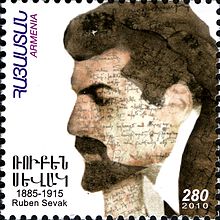Rupen Sevag
Rupen Sevag (also Sevak , Armenian Ռուբէն Սեւակ Ruben Sewak , actually Rupen Hovhannesi Chilingirian ; born February 15, 1885 in Silivri , Ottoman Empire ; † probably August 26, 1915 near Çankırı ) was an Ottoman-Armenian poet, prose writer and doctor. He was one of the first victims of the Armenian genocide .
Life
Rupen Sevag's family name was actually Chilingirian . He received his education at the Askanazian School in his native Silivri (near Istanbul ) and the American Middle School in Bardizag near Izmit . In 1901 he moved to Istanbul, where he attended the prestigious Berberian College. After graduating from school, he studied medicine at the University of Lausanne in Switzerland . In 1910 he married the German Helene Apell from Erfurt , with whom he had two children. During the Balkan Wars he was captain of the Ottoman army . He practiced as a doctor in Lausanne until 1914, when he moved back to Istanbul with his family.
On June 22, 1915, he was arrested along with his fellow poet Siamanto and hundreds of other Armenian intellectuals as part of measures against the Armenian elite . Sevag was granted permission to " reside freely in Çankırı " through an August 25 telegram from the Interior Ministry regarding exiles who were incorrectly not listed in an August 3 telegram . However, the prisoners were transported to Çankırı and Ayaş concentration camps , taken from there in small groups to remote places and murdered.
Sevag was attacked and murdered with the intellectuals Taniel Varuschan , Gülustanian, Artin Kocho, Onnik Maghazajian and Dökmeji Vahan on the transport from Çankırı to Ayaş in the village of Tüney. The authorities and interior minister Talât Pascha blamed a Kurdish gang named Kurd Alo for this and brought them to a military court in 1915. After the end of the war, the Istanbul Military Court confirmed in proceedings against representatives of the Committee for Unity and Progress (KEF) from April 1919 to February 1920 that Kurd Alo was the immediate perpetrator. However, as the organizers of the attack, it sentenced Cemal Oğuz , secretary of the KEF in Çankırı, and police chief Nureddin Bey to five years and six years and eight months in prison, respectively, during which Nureddin was absent from the trial.
His house in Pangaltı near Şişli is now a museum.
plant
Rupen Sevag's first poem was printed in 1905. The Asadamard (freedom fight ), an official newspaper of the Taschnaken , printed its prose pieces under the title “From the diary of a doctor” in Istanbul in 1913/14. As early as 1910, “Das Rote Buch” was published, his only book published during his lifetime.
Sevag is best known as a lyric poet who wrote in the tradition of Armenian love poetry. In addition, he wrote numerous love songs that were greatly celebrated for their feelings and depth. The freshness and accuracy of his language are characteristic of his poetry. In addition, his poetry is known for the different dimensions and musicality. Sevag is one of the most patriotic and humanistic poets and is now honored as an Armenian hero. His poetry sums up the history and essence of West Armenian literature while creating an entirely new genre.
Web links
Individual evidence
- ^ A b A. J. Hacikyan, G. Basmajian, ES Franchuk, N. Ouzounian (eds.): The Heritage of Armenian Literature. From The Eighteenth Century To Modern Times. Wayne State University Press, 2005, p. 858
- ↑ Georges Balakian : Le Golgotha arménien , Le cercle d'écrits caucasiens, La Ferté-Sous-Jouarre 2002 (Vol. 1) ISBN 2-913564-08-9 page 442
- ↑ Kantian, Raffi. The poet and his wife. Rupen Sevag & Helene Apell. An Armenian-German couple in the times of genocide in: Armenisch-Deutsche Korrespondenz, No. 139, vol. 2008 / issue 1, pages 46
- ↑ Kastamonu Vilâyeti'ne. State Archives of the Republic of Turkey, archived from the original on March 3, 2009 ; Retrieved May 19, 2014 (Turkish).
- ↑ Taner Akçam : Young Turks' Crime Against Humanity: The Armenian Genocide and Ethnic Cleansing in the Ottoman Empire. Princeton University Press, 2012, pp. 217-220.
- ↑ Jacques Derogy: Resistance and revenge: The Armenian Assassination of the Turkish Leaders Responsible for the 1915 massacres and deportation. Transaction Publishers, 1990, p. 39.
- ↑ Kristin Saleri'ye "Geçmiş Olsun: Ziyareti. (No longer available online.) In: Lraper. Archived from the original on September 26, 2007 ; retrieved on March 4, 2006 (Turkish). Info: The archive link was automatically inserted and still not checked. Please check the original and archive link according to the instructions and then remove this notice.
| personal data | |
|---|---|
| SURNAME | Sevag, rupees |
| ALTERNATIVE NAMES | Chilingirian, Rupen Hovhannesi |
| BRIEF DESCRIPTION | Armenian poet |
| DATE OF BIRTH | February 15, 1885 |
| PLACE OF BIRTH | Silivri , Ottoman Empire |
| DATE OF DEATH | uncertain: August 26, 1915 |
